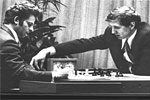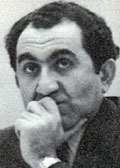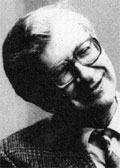


Winning starts with what you know
The new version 18 offers completely new possibilities for chess training and analysis: playing style analysis, search for strategic themes, access to 6 billion Lichess games, player preparation by matching Lichess games, download Chess.com games with built-in API, built-in cloud engine and much more.

Ultimately chess is just chess - not the best thing in the world
and not the worst thing in the world, but there is nothing quite like it.
– W.C. Fields
In last month's column A great moment in chess (Part 1), we followed the Fischer-Spassky World Championship Match of 1972 to the point where Fischer finally arrived in Reykjavik on July 4th, just hours before the expiration of FIDE president Max Euwe's deadline.
Now that Fischer was on the island, not all problems had disappeared. As Gudmundur Thorarinsson, President of the Icelandic Chess Federation, indicated: “You Americans think the only problem is to get Bobby here. You don't understand it is just as important – and maybe more difficult – to keep the Russians here.”
Indeed, the Russians were infuriated by the two-day postponement that Euwe had granted to Fischer. And there were discussions on their side to call off the match. Several meetings took place in Reykjavik behind the scenes, at all hours of the day and night. At the highest level, the level of the Central Committee of the Communist Party of the Soviet Union, the view was held that Fischer's conduct constituted a humiliation of the World Champion. And there are indications that at least for a while, efforts were under way to summon Spassky home. A strongly worded telegram was sent to Grandmaster Lothar Schmid, the German referee of the match, by the Soviet Chess Federation complaining about Fischer's conduct and Euwe's reaction to it. The US ambassador to Iceland, Theodore Tremblay, informed his superiors in Washington that the Russian side had become difficult to the point that the entire match again was threatened.
At this critical moment, Thorarinsson decided to seek assistance from the Icelandic Prime Minister Olafur Johannesson. The Prime Minister promptly contacted the Soviet Ambassador, Sergei Astavin, asking him to personally use his influence in making sure the Russian delegation would stay. Also, on July 6th, Fischer unexpectedly apologized to Spassky, both verbally and in writing, and after this gesture the match seemed again to be saved.
The drawing of colors finally took place on the evening of July 7th in the playing hall. Journalist Brad Darrach gives a first-hand account of the event: “At 8:45 the ceremony began. When Spassky strolled on stage, he got a big hand. Bobby was given a much fainter ovation. Spassky drifted to the chess table and inspected it calmly; he had seen it once before. Bobby, who had never seen the physical arrangements for the match, glanced quickly about the stage. (…) The table was an angular, modern piece of heavy mahagony, rubbed to a red-gold glow. Cream-colored leather cushions had been let into the edges for the players to lean on. (…) Bobby stared down at it for at least a minute without moving. The hall fell silent. (…) Then Bobby's hand moved slowly toward the chessboard until at last, lovingly, he touched the White King.
When Geller [Spassky's second] had announced that the Champion's conditions had been met and he would play, Schmid invited Spassky to choose one of the two envelopes he was holding. Spassky picked the envelope containing Bobby's name. This choice gave Bobby »the right to choose colors from Pawns held in the hands of the other player«. Spassky picked up a Black Pawn and a White Pawn, turned his back and then turned to face Bobby with his fists closed. Bobby confidently reached out and tapped Spassky's right hand.(…) Spassky opened his right hand and displayed – a Black Pawn. Bobby gave a little start, then looked away. »Mr. Fischer has selected Black«, Schmid announced. »Mr.Spassky, therefore, has White and will make the first move in the first game of the match, which will begin on Tuesday, July 11, at 5:00 in the afternoon.«”
Prior to their Reykjavik encounter, the two protagonists had contested five games, resulting in three wins for Spassky and two draws. On every occasion he had played the white pieces against Fischer, Spassky had opened with the Queen's Pawn, while in his world title match with Petrosian, which won him the crown, Spassky had built his repertoire around 1.e4.
After almost a year of extensive and systematic preparation, what will he
now play against Fischer. Did his team's microscopic study of Fischer's games
unearth subtle weaknesses in his opponents handling of closed systems or will
it have convinced Spassky to openly strike at Fischer with 1.e4 – the
most daring move against Fischer's repertoire, inviting Poison Pawn variations
of the Sicilian complex, hence demonstrating a willingness to enter the most
dangerous lines which Fischer has analysed for years.
And one should not forget that virtually all of the top Russian chessplayers
were involved in assisting Spassky during his preparation: Karpov played secret
training matches with Spassky, Tal as well as Petrosian, Keres, Smyslov wrote
detailed confidential memos about Fischer's strengths and weaknesses. Some of
these have only recently surfaced from Russian archives. Here are quotes from
a selection of these memos.
 Tal:
”In the Sicilian Defence Fischer, as a rule, sticks to well-tried systems
when playing White. These are the Sozin variation (2…Sc6 and 5…d6),
the Rauzer Attack, and the Dragon variation – systems with g3 (I think
that 5.Nb5 can be dismissed) against the Paulsen variation. The only variation
in which Fischer does not always stick to the same moves is his favourite 2…d6
and 5…a6. Also 6.Bc4, 6.h3, and 6.Bg5. Perhaps, the American should be
»sounded out« – 24 games provide enough time for that.
Tal:
”In the Sicilian Defence Fischer, as a rule, sticks to well-tried systems
when playing White. These are the Sozin variation (2…Sc6 and 5…d6),
the Rauzer Attack, and the Dragon variation – systems with g3 (I think
that 5.Nb5 can be dismissed) against the Paulsen variation. The only variation
in which Fischer does not always stick to the same moves is his favourite 2…d6
and 5…a6. Also 6.Bc4, 6.h3, and 6.Bg5. Perhaps, the American should be
»sounded out« – 24 games provide enough time for that.
Fischer's reaction to 1…c6 appears to be not to impressive. In any case,
the system he used against Petrosian ought not to be too dangerous. Also, in
my view, his reaction to 3…Nf6 in the Ruy Lopez (he used 6. Bg5 at a tournament
in the USA) can hardly be a potent argument against this system.
If it were possible to divert Fischer from his favourite system in the Sicilian
Defence, Spassky's task would be greatly facilitated. I am sure that you are
exploring ways to do so (for instance, 6.Bg5 and 6.Be2 – Geller).
I would like to draw your attention to the sequence of moves 1.e4 c5 2.Nf3 d6 3.Nc3. In the two games known to me Fischer did not play 3…Nf6. Against Kurajica (Zagreb 1970) he continued 3…Na6, and in a lightning chess tournament against me he played 3…e5. In both games Fischer's opening position was dubious. Perhaps he doesn’t like 4. e5?”
 Petrosian:
Petrosian:
(a) The Sicilian Defence with 2…d6 and 5…a6 is currently going through a serious crisis in the case of both 6.Be2 and 6.Bg5. It is a matter of taste which plan is to be preferred and perfected.
(b) Against the King's Indian Defence and the Grunfeld Defence, systems must be chosen that give White a pawn preponderance in the center.
(c) In reply to 1.e4 practically any opening can be used against Fischer with the exception of 1…e5 (the Ruy Lopez). (d) Fischer has to be »raced« through many openings playing both White and Black.
 Keres:
”Because Fischer hardly ever plays anything but 1.e4 when White, preparation
is fairly circumscribe. Fischer's range when playing Black is also fairly narrow:
in response to 1.e4 he chooses the Sicilian Defence and in response to 1.d4
he prefers the King's Indian Defence, the Grunfeld Defence, or the Queen's Gambit.
He tries to steer the game towards these systems after 1.Nf3, too, and often
responds with 1…c5 to 1.c4. Perhaps, then he can be caught out with the
Tarrasch Defence, colours reversed? Fischer has hardly ever played this opening,
while Spassky likes it and plays it superbly. In general, such a strategic opening
with some exciting tactical possibilities seems to be a suitable weapon, especially
because White has made an extra move.(…).
Keres:
”Because Fischer hardly ever plays anything but 1.e4 when White, preparation
is fairly circumscribe. Fischer's range when playing Black is also fairly narrow:
in response to 1.e4 he chooses the Sicilian Defence and in response to 1.d4
he prefers the King's Indian Defence, the Grunfeld Defence, or the Queen's Gambit.
He tries to steer the game towards these systems after 1.Nf3, too, and often
responds with 1…c5 to 1.c4. Perhaps, then he can be caught out with the
Tarrasch Defence, colours reversed? Fischer has hardly ever played this opening,
while Spassky likes it and plays it superbly. In general, such a strategic opening
with some exciting tactical possibilities seems to be a suitable weapon, especially
because White has made an extra move.(…).
White in response to Sicilian Defence 2…d6 and 5…a6: It is a very complicated system, which, after 6.Bg5, calls for a lot of preparation. Because Fischer has worked a lot on this and knows the position well I would not recommend 6.Bg5 unless the situation is desperate. I believe that 6.Be2 would be more practicable, especially because Geller is a great connoisseur of that system. Consideration can also be given to 6.f4 which often gives White a chance to attack the king. The move 6.Be3 has not been sufficiently explored for any judgments to be passed on it.”
 Smyslov:
”The repertoire of openings must be diversified and tailored to Fischer's
specific variations.
Smyslov:
”The repertoire of openings must be diversified and tailored to Fischer's
specific variations.
a) For instance, one may consider 6.Be2 in the Sicilian Defence with the Knight moving from f3 to b3. Any scheme must be carefully thought out and hold the promise of parity if an advantage is not gained. In other words, a large safety margin must be created.
b) In reply to the King's Indian Defence the Samisch system can be used, and also a calm development, for example, 1.d4 Nf6 2.c4 g6 3.Nc3 Bg7 4.Nf3 d6 5.Bg5, etc. In the Grunfeld Defence it would be interesting to explore the system with 4.Qb3 and 4.Bf4.
c) In reply to 1.e4, classical systems with 1…e5 must be prepared. I can recommend the Petroff Defence as well as the Ruy Lopez in its classical shape with Nc6-a5 and c7-c5 modelled on Fischer's games with Kholmov (Havana 1965) and O'Kelly (Buenos Aires 1970) updated in line with modern theory.
d) I do not believe in the strength of Black's defence in the variation much favoured by Fischer: 1. c4 c5 2. Nf3 g6 3. d4 cd4 4. Nd4. The Maroczy formation with pawns at c4 and e4 promises a solid initiative to White.”
Tuesday, July 11th, then saw the eagerly expected first game. At 4:56 p.m. Spassky entered the main auditorium of Laugardalshall, the playing venue, and was greeted by referee Lothar Schmid. Schmid walked with him to the chess table and Spassky sat down, Schmid going back to his own table. At 4:59.45 Schmid approched the playing table again and 15 seconds later started Spassky's clock. Almost immediately, Spassky advanced his d-pawn: 1.d4.
Again Fischer was late. At 5:07, he made his entrance on stage, accompanied by Ah's and Oh's from an audience of 3000 spectators and loud applause. After shaking Spassky's hand, Fischer replied with 1…Nf6. Then came 2.c4 e6 [Fischer avoids the King's Indian for which on other occasions he has displaed a clear penchant. Spassky's second Efim Geller, however, is one of the main experts of this defence and certainly Fischer was expecting Spassky to be peppered with novelties.] 3.Nf3 d5 4.Nc3 Bb4 5.e3 0-0 6.Bd3 c5 7.0-0 Nc6 8.a3 Ba5 and a standard position of the Nimzo-Indian was on the board.
Spassky played with great caution and up to move 14, when Fischer deviated, both sides followed a game between Spassky and Krogius from 15 years back. Both players didn't mind simplifications, and at move 28 all officers except a pair of black-squared Bishops had left the board. Then, after Spassky's 29th move, this position was arrived at:
Spassky,Boris V (2660) - Fischer,Robert James (2785) [E56]
World Championship 28th Reykjavik (1), 11.07.1972
1.d4 Nf6 2.c4 e6 3.Nf3 d5 4.Nc3 Bb4 5.e3 0-0 6.Bd3 c5 7.0-0 Nc6 8.a3
Ba5 9.Ne2 dxc4 10.Bxc4 Bb6 11.dxc5 Qxd1 12.Rxd1 Bxc5 13.b4 Be7 14.Bb2 Bd7 15.Rac1
Rfd8 16.Ned4 Nxd4 17.Nxd4 Ba4 18.Bb3 Bxb3 19.Nxb3 Rxd1+ 20.Rxd1 Rc8 21.Kf1 Kf8
22.Ke2 Ne4 23.Rc1 Rxc1 24.Bxc1 f6 25.Na5 Nd6 26.Kd3 Bd8 27.Nc4 Bc7 28.Nxd6 Bxd6
29.b5

Black to move
A position with no winning chances for either side and very definitely drawn. In fact, 500 spectators had left and about an equal number was hanging around in the lobby and the restaurant, waiting for the inevitable pieceful conclusion of the game. Then, the unbelievable happened. Fischer took his bishop and captured Spassky's pawn on h2, allowing his bishop to be trapped, a move which even middle-class players would have rejected out of hand. In consternation, Spassky jerked as if hit by a bullet, then looked at the board in disbelief. Instantly, people in the lobby were yelling and shouting, trying to get back into the auditorium. Gudmundur Thorarinson displayed a fantastic grin: “One move and we hit every front page everywhere in the world.”

Spassky vs Fischer, 1972 in Reykjavik
Addendum: originally the ChessBase.com editors had captioned the above picture "Fischer executing the move 29...Bxh2 on July 11, 1972 in Reyjkavik", perpetuating an urban legend. A number of readers noted that Fischer is capturing on the right (queen) side of the board, and that there are rooks still present. Ergo: it could not be the first game and certainly not the bishop capture. Jon Crumiller of Princeton, New Jersey writes: "The
position appears to be from the 21st game, August 31, 1972, after White's
20th move Rxd5, and immediately before Black's 20th move ...Bxh2+ (this
coincidence could help explain the mislabeled caption). But Fischer is
not executing the move ...Bxh2+ at that moment, he is reaching for White's
Queenside; my guess would be that he is adjusting a piece (j'adoube) or
else pushing away a piece that had already been captured, perhaps the
Knight that he captured the prior move." Chess mystery: does anyone
have a better explanation? |
In their most recommendable book “Bobby Fischer goes to war”, the two BBC-reporters David Edmonds and John Eidinow write: “In 1992, when Fischer and Spassky played a rematch, a journalist, still intrigued by the move two decades earlier, asked Fischer whether he had been trying to create winning chances by complicating a drawn position.”Basically that's right. Yes,” he replied. At the time, however, he offered a different explanation, claiming to Lombardy [his second] that he had reacted too fast because the cameras distracted him.”
When the game was continued the next day, Fischer left the playing table for half an hour and strongly protested the presence of the television cameras to Grandmaster Schmid. Then he resigned on move 56.
29...Bxh2 30.g3 h5 31.Ke2 h4 32.Kf3 Ke7 33.Kg2 hxg3 34.fxg3 Bxg3 35.Kxg3 Kd6 36.a4 Kd5 37.Ba3 Ke4 38.Bc5 a6 39.b6 f5 40.Kh4 f4 41.exf4 Kxf4 42.Kh5 Kf5 43.Be3 Ke4 44.Bf2 Kf5 45.Bh4 e5 46.Bg5 e4 47.Be3 Kf6 48.Kg4 Ke5 49.Kg5 Kd5 50.Kf5 a5 51.Bf2 g5 52.Kxg5 Kc4 53.Kf5 Kb4 54.Kxe4 Kxa4 55.Kd5 Kb5 56.Kd6 1-0. [Click to replay]

The Russian delegation naturally was in an effervescent mood: ”We have lift-off!” But there was trouble again on the horizon: The same evening, Fred Cramer, a spokesman for Fischer, sent a letter to the referee in which he demanded that the television cameras be removed entirely. But the American businessman Chester Fox, who had secured all filming rights of the match, refused to take the cameras out of the auditorium and indeed the Amsterdam Agreement – the match rules agreed to by both players – explicitly allowed filming of the games. (To be continued...)
 About
the author
About
the authorChristian Hesse holds a Ph.D. from Harvard University and was on the faculty of the University of California at Berkeley until 1991. Since then he is Professor of Mathematics at the University of Stuttgart (Germany). Subsequently he has been a visiting researcher and invited lecturer at universities around the world, ranging from the Australian National University, Canberra, to the University of Concepcion, Chile. Recently he authored “Expeditionen in die Schachwelt” (Expeditions into the world of chess, ISBN 3-935748-14-0), a collection of about 100 essays that the Viennese newspaper Der Standard called “one of the most intellectually scintillating and recommendable books on chess ever written.”
Christian Hesse is married, has a six-year-old daughter and a two-year-old son. He lives in Mannheim and likes Voltaire's reply to the complaint: ”Life is hard” – “Compared to what?”.
Previous articles for ChessBase: